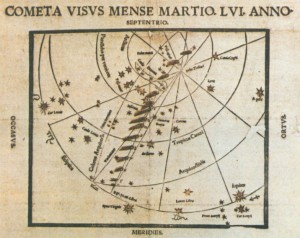This day in Tudor history, 7th March 1556, was one of the days on which the Great Comet, or the Comet of Charles V, was seen and recorded by Paul Fabricius, mathematician and physician at the court of Charles V, Holy Roman Emperor.
Find out all about the Great Comet of 1556, what it looked like and how Emperor Charles V saw it as an ominous portent in today's talk.
Here's the picture I mention:

Also on this day in Tudor history, 7th March 1530, Pope Clement VII threatened to excommunicate Henry VIII if he married again. Find out all about that in last year’s video:
Also on this day in Tudor history:
- 1544 – Executions of Germaine Gardiner, nephew of Stephen Gardiner, and John Larke for denying the royal supremacy. They were hanged, drawn and quartered at Tyburn. Germaine had already been in trouble in 1543 when he was implicated in the Prebendaries' Plot against Archbishop Thomas Cranmer.
- 1544 – Execution of Robert Singleton, clergyman, for treason at Tyburn. Singleton served Thomas Cromwell as a Preacher and Anne Boleyn as a Chaplain before becoming Arch-priest of St Martin's-le-Grand in Dover. It appears that his execution was down to his heretical writings.
- 1574 – Baptism of John Wilbye, composer and musician, at Diss in Norfolk. He composed and published two sets of madrigals, and also contributed “The Lady Oriana”, to a collection in praise of Elizabeth I in 1601, and two madrigals to William Leighton's 1614 collection.
1594 – Death of Sir John Burgh, soldier, from a rapier wound suffered in a duel with John Gilbert, stepbrother of Sir Walter Ralegh. This duel happened during Burgh's second voyage to the West Indies. He was buried in Westminster Abbey, in St Andrew's Chapel.
Transcript:
This day in Tudor history, 7th March 1556, was one of the days on which the Great Comet, or the Comet of Charles V, was seen and recorded by Paul Fabricius, mathematician and physician at the court of Charles V, Holy Roman Emperor.
In the 1848 book “On the expected return of the great comet of 1264 and 1556”, J. R. Hind writes of how the comet is thought to have been visible in some places by the end of February, “but it was not generally observed until the middle of the first week in March.” He explains that “its apparent diameter was equal to half that of the moon” and that its tail, according to a contemporary observer, “resembled ‘the flame of a torch agitated by the wind”. Physician, astronomer and astrologer, Cornelius Gemma, described the head of the comet as being as large as Jupiter, its colour resembling that of Mars, and its tail facing East.
In March 1556, the comet’s course was observed by Fabricius and his observations were published in a pamphlet dated 14th March 1556, along with a map of the comet’s course. Sadly, his pamphlet is no longer extant, and J R Hind explains that all that remained of it was “a small rough chart” which was used by other authors in their works.
Hind writes of how the chart shows that “On the 7th it was in 5° of Libra, and had the same declination as epsilon Virginis; consequently the north latitude would be about 17°.” He adds that “On March 15th, Fabricius observed the comet for the last time, in about 20° of Aries, with a north latitude of 72° or 74°.”
C.D. Hellman notes that another observer of the comet of 1556 was Joachim Heller who recorded first seeing it while travelling on 27th February, although he did not see its tail and so was unsure of what he’d seen until he reached Nuremberg when he was told that a comet with a tail had been observed there in 3rd March. His observations in March and April 1556 were used together with those of Fabricius in 1857 by Dutch astronomer and physicist Martin Hoek in his Ph.D dissertation “The comet of the years 1556, 1264 and 975, and its alleged identity” to make a new computation of the orbit of the 1556 comet and to prove that the comets of 1264 and 1556 were not identical.
At this time, comets were seen as portents of natural disasters, and theologian and historian David Chytraeus recorded Emperor Charles V’s reaction to this comet’s appearance. The emperor said: “By this dread sign my fates do summon me”. It was that year that he left the Low Countries, having abdicated his various offices and titles, and travelled to Spain to spend his final two years in a monastery.



Leave a Reply